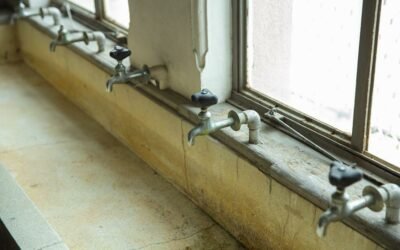Did you know that mold could be the culprit behind your ear infections? Mold spores have a sneaky way of making their way into your ears, potentially leading to middle ear infections.
In this article, we will explore the common symptoms of mold-related ear infections, how mold spores enter the ear, and the steps you can take to prevent mold growth in your home.
Stay informed and discover if mold could be causing your ear troubles.
Key Takeaways
- Mold-related ear infections can cause symptoms such as pain or discomfort in the affected ear, hearing loss, and a feeling of fullness or pressure in the ear.
- Mold spores can enter the ear through inhalation, direct contact with mold-contaminated surfaces, transfer from hands to the ear, and exposure to water creating a moist environment for mold growth.
- There is a potential link between mold and middle ear infections, with the presence of mold in homes associated with an increased risk of middle ear infections in children and individuals with a history of mold exposure more likely to experience recurrent middle ear infections.
- Preventing mold growth in the home through controlling moisture levels, regular cleaning and disinfection, using mold-resistant paint, improving air circulation, and maintaining a clean HVAC system can help reduce the risk of ear infections.
Common Symptoms of Mold-Related Ear Infections
If you're experiencing an ear infection caused by mold, you may notice several common symptoms. These symptoms can include pain or discomfort in the affected ear, hearing loss or muffled hearing, a feeling of fullness or pressure in the ear, and drainage from the ear. You may also experience itching or irritation in the ear canal, along with redness or swelling. In some cases, mold-related ear infections can cause dizziness or vertigo, as well as headaches or facial pain.
When mold spores enter the ear canal, they can trigger an inflammatory response in the body, leading to the symptoms mentioned above. It's important to note that not everyone who's exposed to mold will develop an ear infection. Factors such as the individual's immune system, the type and amount of mold present, and the length of exposure can all affect the likelihood of developing an infection.
If you suspect that your ear infection is caused by mold, it's essential to seek medical attention. Your healthcare provider can diagnose the infection and recommend appropriate treatment, which may include antifungal medications or ear drops. Additionally, they may advise you on ways to prevent future mold exposure and reduce the risk of recurring infections.
How Mold Spores Can Enter the Ear
To understand how mold spores can enter your ear, it's important to be aware of the different ways in which this can occur. Mold spores are tiny particles that can become airborne and easily enter your ear canal.
Here are three ways in which mold spores can enter your ear:
- Inhalation: Mold spores can be inhaled through the nose or mouth and then make their way into the ear canal. This can happen when you're in close proximity to mold-infested areas or when you breathe in air that contains high levels of mold spores.
- Direct Contact: If you touch mold-contaminated surfaces and then touch your ear, the spores can transfer from your hands to your ear. This can occur when you come into contact with moldy objects or surfaces, such as pillows, towels, or even earphones.
- Water Exposure: When water enters your ear, it creates a moist environment that's conducive to mold growth. If the water is contaminated with mold spores, it can introduce them into your ear canal. This can happen during activities such as swimming or bathing in water that contains mold.
It is important to take precautions to minimize your exposure to mold spores and maintain good ear hygiene to reduce the risk of mold-related ear infections.
The Potential Link Between Mold and Middle Ear Infections
There is a potential link between mold and middle ear infections. While more research is needed to fully understand this connection, preliminary studies suggest that exposure to certain types of mold may contribute to the development of middle ear infections, also known as otitis media. The table below provides an overview of the key findings from some of these studies:
| Study | Findings |
|---|---|
| Study 1 | The presence of mold in homes was associated with an increased risk of middle ear infections in children. |
| Study 2 | Individuals with a history of mold exposure were more likely to experience recurrent middle ear infections. |
| Study 3 | Mold spores were detected in the middle ear fluid of patients with chronic otitis media, suggesting a possible role of mold in the infection. |
| Study 4 | Certain species of mold, such as Aspergillus and Penicillium, were found to be more commonly associated with middle ear infections. |
| Study 5 | Mold-related middle ear infections were more prevalent in individuals with compromised immune systems, such as those with allergies or asthma. |
It is important to note that while these studies provide valuable insights, they do not establish a definitive causal relationship between mold and middle ear infections. Further research is needed to determine the exact mechanisms by which mold may contribute to the development of these infections. In the meantime, it is advisable to maintain good indoor air quality, address any moisture issues in the home, and seek medical attention if you or your child experience symptoms of a middle ear infection.
Preventing Mold Growth in Your Home to Reduce the Risk of Ear Infections
Are you wondering how you can prevent mold growth in your home to reduce the risk of ear infections? Mold can potentially cause ear infections, so taking measures to prevent its growth is crucial. Here are three effective ways to keep mold at bay and protect your ears:
- Control moisture levels:
- Mold thrives in damp environments, so it's essential to keep your home dry.
- Use a dehumidifier to reduce humidity levels, especially in areas prone to moisture buildup like bathrooms and basements.
- Fix any leaks promptly and ensure proper ventilation in these areas.
- Regular cleaning and maintenance:
- Regularly clean and disinfect areas prone to mold growth, such as bathrooms, kitchens, and basements.
- Pay attention to areas where moisture can accumulate, like around sinks, showers, and pipes.
- Use mold-resistant paint in high-moisture areas to prevent mold from taking hold.
- Improve air circulation:
- Proper air circulation can help prevent mold growth.
- Open windows and use fans to improve ventilation in your home.
- Avoid blocking air vents and ensure that your HVAC system is clean and functioning properly.
Seeking Medical Treatment for Mold-Related Ear Infections
If you suspect that you have a mold-related ear infection, it's important to seek medical treatment promptly. Mold-related ear infections, also known as fungal otitis externa, can cause significant discomfort and may lead to complications if not properly treated. When you visit a healthcare professional, they'll evaluate your symptoms and conduct a thorough examination of your ears. They may use an otoscope to examine the ear canal and tympanic membrane for signs of infection or inflammation.
In most cases, treatment for mold-related ear infections involves the use of antifungal medications. These medications are typically prescribed in the form of eardrops, which are applied directly to the affected ear. The antifungal medication works to eliminate the fungal infection and reduce inflammation, relieving symptoms such as pain, itching, and discharge. It's important to follow the prescribed treatment regimen and complete the full course of medication, even if symptoms improve.
In some cases, your healthcare professional may also recommend cleaning the ear canal to remove any debris or excess earwax that may contribute to the infection. This can be done using gentle irrigation or suction techniques. It's important to avoid using cotton swabs or other objects to clean the ears, as this can push the fungal infection further into the ear canal and cause additional damage.
If you suspect that you have a mold-related ear infection, don't delay seeking medical treatment. Prompt diagnosis and appropriate treatment can help alleviate symptoms and prevent complications. Your healthcare professional will provide personalized guidance and ensure that you receive the necessary care to resolve the infection and promote healing.
Conclusion
In conclusion, while there's a potential link between mold and middle ear infections, more research is needed to fully understand the relationship.
Common symptoms of mold-related ear infections include pain, itching, and discharge. Mold spores can enter the ear through contaminated water or air.
To reduce the risk of ear infections, it's important to prevent mold growth in your home by controlling moisture levels and practicing good hygiene.
If you suspect a mold-related ear infection, seeking medical treatment is recommended.






0 Comments